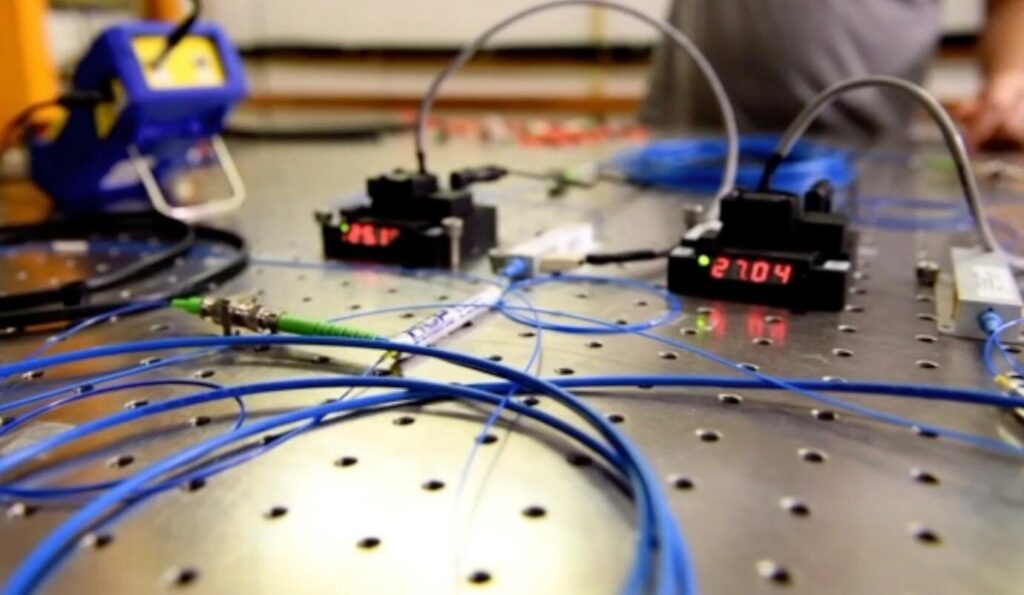A new era of communication is on its way. A viable quantum internet which is a network in which information stored in qubits is shared over long distances through entanglement could transform the fields of data storage, precision sensing, and computing.
Scientists at Fermi National Accelerator Laboratory, a U.S. Department of Energy national laboratory affiliated with the University of Chicago, along with partners at five institutions took a significant step toward realizing a quantum internet.
The team presented for the first time a demonstration of sustained, long-distance teleportation of qubits made of photons (particles of light) with fidelity greater than 90% in a paper published in PRX Quantum.
Qubits were teleported over a fibre-optic network which was 27 miles (44 kilometres) long using state-of-the-art single-photon detectors and off-the-shelf equipment.
Fermilab scientist Panagiotis Spentzouris, head of the Fermilab quantum science program and one of the paper’s co-authors was excited to see such results. He also added that this was a key achievement on the way to build a technology that will redefine how we conduct global communication.
Quantum teleportation is a “disembodied” transfer of quantum states from one location to another. It is achieved using quantum entanglement in which two or more particles are inextricably (impossible to separate) linked to each other. The encoded information is teleported irrespective of the distance between them if an entangled pair of particles is shared between two separate locations.
There was successful teleportation of qubits on two systems: the Caltech Quantum Network and the Fermilab Quantum Network by the joint team of researchers at Fermilab, AT&T, Caltech, Harvard University, NASA Jet Propulsion Laboratory, and the University of Calgary. Caltech’s public-private research program on Intelligent Quantum Networks and Technologies, or IN-Q-NET, was the chief operator who designed, built, commissioned and deployed the systems.
Maria Spiropulu, the Shang-Yi Ch’en professor of physics at Caltech and director of the IN-Q-NET research program, said that they were proud to achieve this milestone on sustainable, high-performing, and scalable quantum teleportation systems. They also added that the results will be further improved with system upgrades by the second quarter of 2021.
Both the Caltech and Fermilab networks, which feature near-autonomous data processing, are compatible both with existing telecommunication infrastructure and with emerging quantum processing and storage devices. Researchers are on their way to improve the fidelity and rate of entanglement distribution, with an emphasis on complex quantum communication protocols and fundamental science.
Spentzouris said that they were beginning to lay the foundation for the construction of a Chicago-area metropolitan quantum network.
The Fermilab in collaboration with Argonne National Laboratory, Caltech, Northwestern University, and industry partners is now designing the Chicagoland network, called the Illinois Express Quantum Network.
Fermilab Deputy Director of Research Joe Lykken concluded by saying the feat was a testament to the success of collaboration across disciplines and institutions, which drives so much of what we accomplish in science.
Journal Reference:
Raju Valivarthi, Samantha I. Davis, Cristián Peña, Si Xie, Nikolai Lauk, Lautaro Narváez, Jason P. Allmaras, Andrew D. Beyer, Yewon Gim, Meraj Hussein, George Iskander, Hyunseong Linus Kim, Boris Korzh, Andrew Mueller, Mandy Rominsky, Matthew Shaw, Dawn Tang, Emma E. Wollman, Christoph Simon, Panagiotis Spentzouris, Daniel Oblak, Neil Sinclair, and Maria Spiropulu Teleportation Systems Toward a Quantum Internet, PRX Quantum (2020). DOI: 10.1103/PRXQuantum.1.020317

